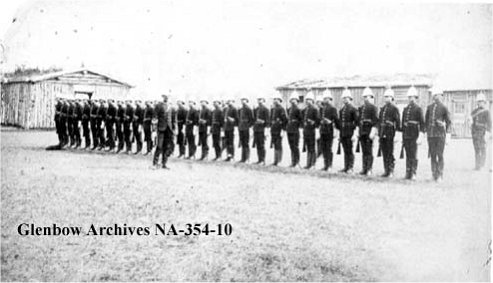North West Mounted Police
In the beginning
The North-West Mounted Police was founded by Parliament on May 23, 1873 in an attempt to establish order in the North-West territories. Their immediate objectives were to stop the liquor traffic, to collect customs dues, to perform all the duties of a police force and establish order in the west. In addition, they would also be tasked with gaining the respect and confidence of the First Nations, and to break them of their old practices by tact and patience.
The new recruits were not exactly a promising bunch. Among the first group to be hired were two that were blind in one eye, five had acute heart disease while others suffered from tuberculosis, syphilis & varicose veins… Interestingly, only the varicose veins were a major concern since they could lead to problems after riding for lengthy periods. Of the lot, only 2 had previous experience in law enforcement. The riding school results weren’t encouraging either, since most had never ridden before and many accidents occurred.
The Cavalcade
The “astonishing cavalcade” made up of 300 hundred men and 310 horses left Fort Dufferin on July 8th 1874 to begin the gruelling trip. After only 10 days, some horses had to be left behind since they were not accustomed to grazing on their own and feed was getting rare. Water and food was also scarce for the men and to make things even worse, the camp kitchen often only arrived after the men had fallen asleep.
Fortunately for them, while in Fort Benton, they hired a Metis guide named Jerry Potts. Potts was born into a tribe of the Blackfoot Nation, but had a Scottish fur trader for a father, so he could walk in both societies without problems. He had seen first-hand what “firewater” (a mixture of thrice-distilled rum, tea, chewing tobacco and red peppers) could do to First Nations society and was inclined to help the Mounties. Mr. Potts has often been referred to the “outright saviour of the hapless Mounties”.

"F" Troop (Source: Glenbow Museum Archive)
Fort Calgary
Late in the summer of 1875, fifty members of the N.W.M.P arrived at the junction of the Bow and the Elbow rivers to create a new fort. The fort was hastily constructed of upright 12-foot pine logs set side by side in a three-foot deep trench and took about 6 weeks to build. The walls and roofs were covered in earth and mud and leaked heavily when it rained. The living conditions in the fort were very hard.
One year later, Colonel James MacLeod named the new fort “Calgary” which is Gaelic for “clear running water”.
The palisade stood until 1882, when it was torn down and more substantial buildings were added. In 1887, a two-story building replaced the men's barracks after it was destroyed by fire. The Mounties occupied the building until 1914. After the Mounties left, the Grand Trunk Pacific Railway bought the land and demolished all of the fort buildings except the Deane House.
The site has been declared a National and Provincial Historic site because of the significance of the archaeological remains.
The New Arrivals
The red-coated officers rapidly build themselves a reputation for practical justice. Colonel MacLeod would rule, without the aid of precedents or legal books, in wagons set up in the middle of the prairies. In the end, they accomplished what the force was created to do.
Since they were here about 10 years before the rush of settlers arrived, they had time to learn how to survive on the prairie and became the “white experts of the land”.
From N.W.M.P to R.C.M.P
King Edward VII officially recognized the North-West Mounted Police when he granted it the prefix Royal in 1904. The force merged with the Dominion Police in 1920 and became known as the Royal Canadian Mounted Polic
Objective
In order to log this cache, you'll need to visit the Fort location and accomplish three tasks:
- Find the cairn, you'll need the date it was placed and the cardinal direction you must be facing in order to read the plaque. (Please note that I've added a picture of what the Cairn looks like)
- How many points are there on an object that was donated by Perl and Jim Burns, Sr.
- How many different individuals are pictured on the plaque labelled "Wars, depression and oil".
Click here to email me your answers to the above questions.
Do not post the answers to these questions in your cache log even if it's encrypted!
Bonus Cache
Also please note that this cache is part of a series called the "Calgary History Tour". The other caches you'll need to find are:
- First Nations (FN)
- N.W.M.P. (NW)
- Settlers & Ranching (SR)
- Cowboys & the Stampede (CS)
- Missionaries (M)
- Politics (P)
- Olympics (WO)
- Outlaws! (O)
There's also a Bonus cache if you complete the series. It can be found HERE.